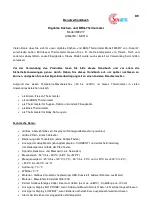
12
13
Figure 5 - Open lid before ignition to
avoid gas buildup.
Figure 6 - Gas control knob.
Figure 7 - Push igniter button for combus-
tion.
Figure 4 - Connect gas cylinder.
1. Check for obstructions of airflow to the burners. Spiders, insects
and webs can clog the burner/venturi tube. A clogged burner/venturi
tube can lead to a fire.
2. Check that the Main Burner ignition wires are connected.
3. Read carefully all instructions contained on the information plate
attached to the barbecue.
4. Check that your gas cylinder is full and properly connected to the
regulator. [Figure 4]
5. Check that there are no gas leaks in the gas supply system. See
“Leak Testing” on page 10.
6.
WARNING:
Open lid before lighting [Figure 5].
WARNING:
DO NOT stand with your head or arms over the grill
7. Set control knobs to “OFF” and turn on the gas supply.
8. For Main Burner: Push and turn either main burner control knob to
“Hi”. [Figure 6]
9. Push the igniter button repeatedly or match light. Burner should
ignite within 5 seconds. (Ignition may perform better with right
control knob or both control knobs set at medium.) [Figure 7]
Match Lighting: Strike and place the burning long wooden match (or
use a match extension, or a butane lighter with extension) through the
spaces in the grill grates near the ports of the burner and follow step
1 through 8 above. Push and turn right control knob to “Hi”. Burner
should ignite within 5 seconds. After the right burner is lit, push and
turn left control knob to “Hi”. Left burner will ignite automatically.
IF BURNER DOES NOT IGNITE:
1. Push and turn control knob to “OFF”. Wait 5 minutes, then try again
with right control knob or both control knobs set at medium.
2. If any burner will not light, consult “Trouble Shooting Guide”. If
problem cannot be resolved, do not attempt to operate the appliance;
contact your dealer or approved service center.
SHUT DOWN:
1. Turn off cylinder valve. Allow gas in line to fully purge by burning
out flames.
2. Turn control knobs to “OFF”.
BURN OFF:
Burn-off. Before cooking on your gas barbecue for the first time, burn
off the barbecue to rid it of any odors or foreign matter as follows:
Remove cooking grids and warming rack and wash in mild soap and
water. Ignite the burner. Close the lid and operate the barbecue
for 20 minutes with the control knobs set at “MEDIUM/HIGH”. Turn
the gas off at the source. Turn the control knobs to “Off”. Let the
appliance cool down, replace the grids. You are now ready to use the
appliance.
PREHEATING:
When grilling, preheat the barbecue on Medium/High with the lid
closed for ten minutes. Reduce heat as appropriate for what you are
grilling. Scrub grids with a wire grill brush and brush or spray the
grids with vegetable or olive oil to prevent food from sticking.
LIGHTING INSTRUCTIONS
LID POSITION:
The position of the lid during cooking is a matter of personal preference, but the barbecue cooks faster, uses less
gas, and controls the temperature best with the lid closed. A closed lid also imparts a smokier flavor to meat cooked
directly on the grill and is essential for smoke and convection cooking.
COOKING TEMPERATURES:
High Setting will produce temperatures at the cooking grid of approximately 600 - 650°F (320 - 340° C). Use this
setting only for fast warm-up and for burning food residue from the cooking grids after the cookout is over. This setting
is also ideal for quickly searing steaks before reducing temperature. Rarely, if ever, do you use the HIGH setting for
extended cooking.
Medium/High Setting will produce temperatures at the cooking grid of approximately 550°F (290 ° C). Use this setting
for warm-up and for grilling steaks and chops,
Medium Setting will produce temperatures inside the barbecue of approximately 450° F (230°C) with the l id down.
Use this setting for most grilling of chicken, burgers, vegetables and for roasting, and baking.
Low Setting will produce temperatures inside the barbecue of approximately 310- 350° F (155-175° C). Use this setting
for all smoke cooking, large cuts of meat, delicate fish, and for dough and pastry such as pizza and quesadillas.
These temperatures are approximate only and vary with the outside temperature and the amount of wind present.





























